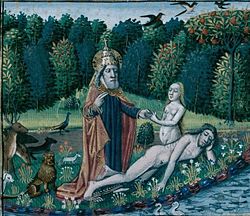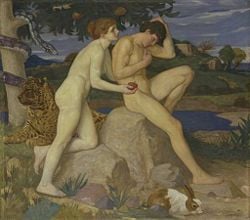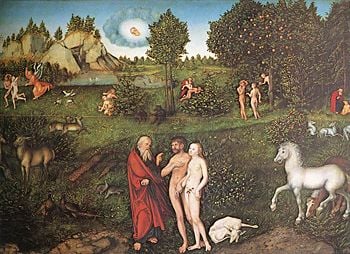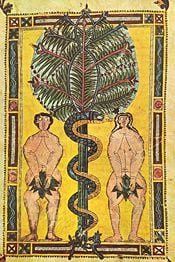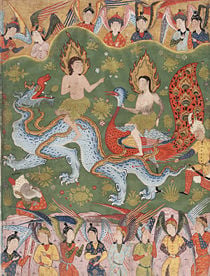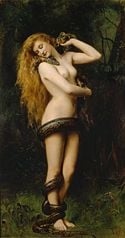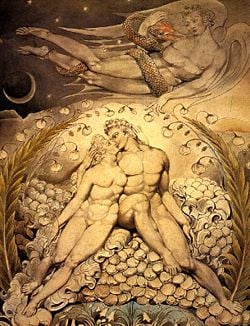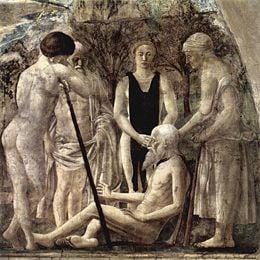Difference between revisions of "Adam and Eve" - New World Encyclopedia
| Line 50: | Line 50: | ||
[[Image:Cranach.jpg|thumb|350px|God speaks to Adam and Eve, with various other scenes from their story in the background.]] | [[Image:Cranach.jpg|thumb|350px|God speaks to Adam and Eve, with various other scenes from their story in the background.]] | ||
As a result of these events, God curses all three of the characters in the drama: the serpent must crawl on his belly and eat dust; the woman must suffer increased pain in childbearing and be ruled by her husband; and the man must labor for his food instead of eating freely of what grows in the Garden, for the land too is cursed. These curses can be seen as analogues to the blessings given earlier in Gen. 1:28. | As a result of these events, God curses all three of the characters in the drama: the serpent must crawl on his belly and eat dust; the woman must suffer increased pain in childbearing and be ruled by her husband; and the man must labor for his food instead of eating freely of what grows in the Garden, for the land too is cursed. These curses can be seen as analogues to the blessings given earlier in Gen. 1:28. | ||
| + | |||
| + | However, the curse upon the serpent contains what Christian exegetes have long regarded as a hidden prophecy of [[Jesus Christ|Christ]] to come in the words, "He (the woman's seed) will bruise your head, and you shall bruise his heel." (Gen. 3:15) This is said to foretell the [[crucifixion]], by which Christ will strike the head of Satan while taking damage in his flesh. | ||
God then confirms the serpent's prophecy to Eve: "The man has now become like one of us, knowing good and evil." (Gen 3:21) To prevent Adam from also partaking of the [[Tree of Life]] and living forever, God casts him out of the Garden, posting [[cherubim]] and a flaming sword to guard the entrance. The death that Adam and Eve undergo when they eat the fruit is a spiritual death—separation from God and His blessings. Physically they live for many more years. | God then confirms the serpent's prophecy to Eve: "The man has now become like one of us, knowing good and evil." (Gen 3:21) To prevent Adam from also partaking of the [[Tree of Life]] and living forever, God casts him out of the Garden, posting [[cherubim]] and a flaming sword to guard the entrance. The death that Adam and Eve undergo when they eat the fruit is a spiritual death—separation from God and His blessings. Physically they live for many more years. | ||
Revision as of 04:03, 4 October 2007
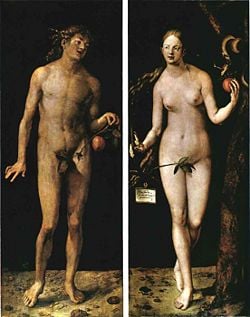
Adam (Hebrew: אָדָם, Adam, "man"; and Eve (Hebrew: חַוָּה, Ḥavva, "living one") were the first man and woman created by God, according to the Bible and the Qur'an. The story of Adam and Eve is central to the widely held belief that God created human beings to live in a Paradise on earth although they fell away from that state and formed the present world full of suffering and injustice. It provides the basis for the belief that humanity is in essence a single family, with everyone descended from a single pair of original ancestors. It also provides much of the scriptural basis for the doctrine of Original Sin, an important belief in Christianity, although not shared by Judaism or Islam.
The story of Adam and Eve is told in the early chapters of the Book of Genesis, which describes the creation of man and woman, the temptation and the Fall, the expulsion from Eden, the story of the first murder, and the subsequent peopling of the world outside the Garden of Eden. It is the source of many of the most important symbols in Western culture, including the Garden of Eden, the Tree of Life and the Tree of the Knowledge of Good and Evil, the forbidden fruit, and the serpent as Satan.
Adam and Eve's story underwent extensive elaboration in later Abrahamic traditions, and has been extensively analyzed by modern biblical scholars.
Biblical account
The creation of man and woman
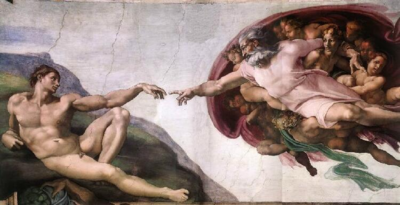
In the Book of Genesis, the creation of man and woman takes place after six "days" of creation in which God first brings into being the heavens and the earth, light, day and night, sky and sea, dry land, trees and other vegetation, the sun and the moon, sea creatures and birds, and finally livestock and wild animals. Then later on the sixth day, God decides to "make man in our image, in our likeness." The manifestation of God's image in "man" is both masculine and feminine:
- So God created man in his own image,
- in the image of God he created him;
- male and female he created them. — Gen. 1:27
God proceeds to bless the couple to, "Be fruitful and increase in number; fill the earth and subdue it. Rule over the fish of the sea and the birds of the air and over every living creature that moves on the ground." (Gen. 1:28) God gives them, "every tree that has fruit with seed in it" to eat. At the conclusion of this sixth day of creation God declares His work to be "very good" and proceeds to rest on the seventh day.
In the Jewish and Islamic traditions, the creation of humanity out of a single pair is signifies the moral unity and equality of humanity:
- But a single man [Adam] was created for the sake of peace among mankind, that none should say to his fellow, “My father was greater than your father.” (Mishnah, Sanhedrin 4.5)
- O mankind! We created you from a single pair of a male and a female and made you into nations and tribes, that you might know each other [not that you might despise each other]. Verily the most honored among you in the sight of God is he who is the most righteous. (Qur’an 49.13)
Genesis 2 contains a second account of the creation of human beings. However unlike the first account which is chronological, the second one focuses on the theological significance of Adam and Eve. God forms Adam out of clay and breathes into him the "breath of life." (Gen. 2:7) Receiving this divine breath makes the man unique among all God's creations, which are made from the earth only. This verse provides a theological basis for making a qualitative distinction between human beings and animals, as only humans possess an eternal spirit. For some Protestants, the verse is also relevant to the abortion debate by providing a rationale for seeing the fullness of human life as beginning at birth when the baby takes its first breath, rather than as Catholics believe at conception when the "clay" has not yet been infused with spirit.
God places the man in the Garden of Eden, where he causes all kinds of trees to grow, including two special trees: the Tree of Life and the Tree of the Knowledge of Good and Evil. Adam is told that he is free to eat of any tree he wishes, except one. God commands that he must not eat of the Tree of the Knowledge of Good and Evil, warning him that, "in the day you eat of it, you shall die." (Gen. 2:17).
Institution of the family
God seeks companions for Adam and so creates the animals and brought them to Adam to give them names. As naming signifies dominion, this indicates human beings are more important than animals (compare Gen. 1:28). However, none of them satisfy Adam's loneliness and need for companionship. To create a companion, God forms a woman out of Adam's rib (Gen. 2:22). This means that woman is of the same substance as man. On this point, Thomas Aquinas wrote:
- It was right for woman to be made from a rib of man. First, to signify the social union of man and woman, for the woman should neither use authority over man, and so she was not made from his head; nor was it right for her to be subject to man’s contempt as his slave, and so she was not made from his feet.[1]
A Jewish tradition, also found in Gnostic texts, holds that God originally created Adam as a hermaphrodite (Midrash Rabbah, Genesis 7:1) so that Adam was both male and female. God later decided that "it is not good for him to be alone," and brought the feminine Eve out of Adam, leaving Adam as masculine only.
With the creation of woman, Adam and Eve are complete, and after God brings the woman to the man, their oneness is confirmed: "This at last is the bone of my bones, and flesh of my flesh" (Gen. 2:23). This leads to the ordaining of the institution of marriage and family:
- "Therefore a man leaves his father and his mother and cleaves to his wife, and they become one flesh." (Genesis 2:24)
Some Jewish traditions interpret this verse indicated that Adam and Eve enjoyed married life in the Garden, and the traditional Jewish wedding prayer refers to the joyous marriage of Adam and Eve. According to one midrashic account, when God blessed Adam and Eve in marriage, the angels danced and beat timbrels and stood guard over their bridal chamber (Pirḳe R. El. 12-13). However, most Christian interpreters do not believe that this marriage was consummated in the Garden of Eden; rather it was after the couple had been expelled that "Adam knew Eve his wife, and she conceived..." (Gen. 4:1).
The human fall
For a time, Adam and Eve obeyed the one commandment they have been given, to refrain from eating of the forbidden fruit. However, one day, a serpent came to Eve and persuaded her to eat it. "God knows that when you eat of it your eyes will be opened," he told her, "and you will be like God, knowing good and evil." The serpent showed Eve that the fruit was, "good for food and pleasing to the eye, and also desirable for gaining wisdom," and so she ate it. She then gave some of the fruit to Adam, and he too ate. Adam and Eve immediately realized that they were naked, and became of ashamed of this, using fig leaves to cover their sexual organs.
In all the Abrahamic faiths, the serpent is linked with the figure of Satan, as in this New Testament verse: "That ancient serpent, who is called the Devil and Satan, the deceiver of the whole world..." (Revelation 12:9) As to what action is symbolized by eating the forbidden fruit, Christian theologians are generally vague, focusing entirely on the disobedience that the deed entailed. Jewish tradition, on the other hand, is quite explicit that Satan (either in person or utilizing a serpent) seduced Eve. The Slavonic Book of Baruch, xcvii, says that the serpent had infused lust into the fruit, and when Eve ate it sexual desire was awakened in her. The Bahir, a Kabbalistic text, states: "The serpent followed Eve, saying, 'Her soul comes from the north, and I will therefore quickly seduce her.' And how did he seduce her? He had intercourse with her." (Bahir 199) In the Pirke d'Rab. Eliezer, Satan persuaded the serpent to act on his behalf and "Be my instrument, and through thy mouth will I utter a word which shall enable thee to seduce man" (Pirḳe R. El. xiii.). In another tradition, Eve became the lover of Satan in the Garden of Eden, and Satan impregnated Eve to become the father of Cain (Pirḳe R. El. 13). The New Testament contains an echo of this idea in Jesus' statement, "You are from your father the Devil." (John 8:44)
Soon, God walks through the Garden looking for Adam and Eve, but he cannot find them, because they are hiding from him. God calls out to Adam: "Where are you?" (Gen. 3:9) Adam responds, "I heard your voice, and I was afraid, because I was naked." God replies: "How did you know you were naked? Did you eat of the fruit of the tree I told you not to eat of?" By asking a question instead of judging and condemning him, God is giving Adam the opportunity to own up to what he has done and repent. However Adam doesn't take responsibility for his action and instead puts the blame on Eve. When God asks Eve a question she too fails to fails to take responsibility and instead she blames the serpent.
As a result of these events, God curses all three of the characters in the drama: the serpent must crawl on his belly and eat dust; the woman must suffer increased pain in childbearing and be ruled by her husband; and the man must labor for his food instead of eating freely of what grows in the Garden, for the land too is cursed. These curses can be seen as analogues to the blessings given earlier in Gen. 1:28.
However, the curse upon the serpent contains what Christian exegetes have long regarded as a hidden prophecy of Christ to come in the words, "He (the woman's seed) will bruise your head, and you shall bruise his heel." (Gen. 3:15) This is said to foretell the crucifixion, by which Christ will strike the head of Satan while taking damage in his flesh.
God then confirms the serpent's prophecy to Eve: "The man has now become like one of us, knowing good and evil." (Gen 3:21) To prevent Adam from also partaking of the Tree of Life and living forever, God casts him out of the Garden, posting cherubim and a flaming sword to guard the entrance. The death that Adam and Eve undergo when they eat the fruit is a spiritual death—separation from God and His blessings. Physically they live for many more years.
Life outside paradise
Adam and Eve now begin their lives outside Eden and raise a family. Their first child is called Cain, and their second is named Abel. When they grow up, Cain becomes a farmer and Abel becomes a shepherd. Later, the two brothers each offer a sacrifice to God: Cain brings an offering of his crops, while Abel offers a sacrifice from his flocks. God accepts Abel's offering but rejects Cain's. As a result, Cain becomes dejected. God asks Cain why he is angry and tells him that if he does well he too will be accepted. On the other hand, if he does not, "sin is crouching at the door; its desire is for you, but you must master it." This phrase indicates that human beings are not determined. On the contrary, each person has the freedom to choose and is thus responsible for their actions. However, Cain does not change his outlook. Instead, he lures Abel into the field and kills him. Cain flees to the east, where his wife—not previously mentioned—gives birth to Adam and Eve's first grandson, Enoch.
After this, Adam and Eve have another son, Seth, and Eve declares "God has granted me another child in place of Abel, since Cain killed him." After Seth grows to maturity, he becomes the father Enosh. It is Seth's line that produces Noah, through whom humanity's lineage is perpetuated after the Great Flood.
A separate account of Adam's genealogy is given in Genesis 5. Here, neither Cain's nor Abel's lineage is mentioned. It is therefore assumed that Abel died without children. This account specifies that Adam was 130 years old when he became the father of Seth. It also claims that Adam lived 930 years before he died. Although Eve is not mentioned in this genealogy she is given the title "the mother of all living." (Gen. 3:20)
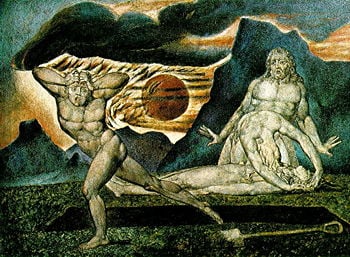
The Bible refers to other sons and daughters of Adam, but they are not named in the Bible. (Gen. 5:4) The biblical account requires that there be daughters in order to provide wives for the sons. The Book of Jubilees, a pseudepigraphic text from the second century B.C.E., names two daughters: Azûrâ and Awân, plus nine other sons, making 12 sons and two daughters in all. Jubilees goes on to state that Cain later married Awân, and Seth married Azûrâ. According to other Jewish traditions, Cain had a twin sister named Lebuda, and Abel had a twin sister named Qelimath. In the Conflict of Adam and Eve with Satan, Cain's twin sister is named Luluwa, and Abel's twin sister is named Aklia.
Original Sin
The story of Adam and Eve forms the basis for the important Christian doctrine of Original Sin: "Sin came into the world through one man and death through sin, and so death spread to all men because all men sinned," said Paul of Tarsus in his Epistle to the Romans, writing in about 58 C.E. Later theological commentators directly connected Adam and Eve's disobedience to God's word as the foundation of mankind's sinful nature. St. Augustine of Hippo (354-430 C.E.) understood Paul to have taught that Adam's sin was hereditary. He held that Original Sin passed on from generation to generation through the father's sperm in the act of sexual intercourse.
Christian belief connects the Original Sin to the atoning work of Christ which cleanses it. The New Testament teaches that Jesus is the new Adam who brings regenerating life to Christians. As Saint Paul wrote:
- The first man Adam became a living being; the last Adam, a life-giving spirit. The first man was of the dust of the earth, the second man from heaven. (1 Cor. 15:45-47)
As the second Adam, Jesus succeeded where the first Adam failed. Thus, Jesus was obedient to the point of death on the cross, restoring Adam's disobedience of the commandment which held the penalty of death (Gen. 2:17) — or as Saint Paul put it, "For as in Adam all die, so also in Christ shall all be made alive" (1 Cor. 15:22). Jesus overcame Satan through his forty days on the Mount of Temptation thus restoring Adam who succumbed to Satan's temptation in the Garden. Based on Christ's redemption, baptism is understood in Catholic and some Protestant traditions as the means of washing away the stain of Original Sin. (In other branches of Christianity, baptism is a means of cleansing only the sins that were actually committed by the person being baptized.)
Because Eve had tempted Adam to eat of the fatal fruit, several of the early Fathers of the Church held her, and all subsequent women, to be especially responsible for the Fall. "You are the devil's gateway," Tertullian told his female listeners in the early second century. [2] Although there is no mention of a new Eve in the New Testament, in Catholic tradition, Mary, the mother of Jesus, is seen as restoring Eve's sin by her giving birth to Jesus as a virgin. Justin Martyr, (165 C.E.) wrote, "Christ became a man by a virgin to overcome the disobedience caused by the serpent ...in the same way it had originated." (Dialogue with Trypho) Irenaeus of Lyon stated: "The knot of Eve's disobedience was loosened by Mary's obedience." (Adv. haereses, 3:22) And Ambrose of Milan (397 C.E.) said, "It was through a man and woman that flesh was cast from paradise; it was through a virgin that flesh was linked to God."
Adam and Eve in the Qur'an
The Qur'an tells of آدم (ʾĀdam) in the surahs al-Baqara 2:30-39, al-A'raf 7:11-25, al-Isra 17:61-65, and Ta-Ha 20:115-124, where he is mentioned by name. In addition, the Qur'an repeatedly describes the creation of human beings from a single pair, sometimes with an allusion to the biblical narrative of the creation of Eve from Adam's rib:
- O mankind! Fear your Lord, who created you of a single soul, and from it created its mate, and from the pair of them scattered abroad many men and women. (Qur’an 4.1)
- O mankind! We created you from a single pair of a male and a female and made you into nations and tribes, that you might know each other [not that you might despise each other]. Verily the most honored among you in the sight of God is he who is the most righteous. (Qur’an 49.13)
As mentioned above, this is the basis for the Islamic belief in human equality and the essential unity of the human race.
Adam in the Garden of Eden is portrayed a glorious being, endowed with wisdom, and higher than the angels. When God orders the angels to bow to Adam, one of those present, the Jinni Iblis refuses, due to his pride, and assumes the role of Shaitan, the Tempter. This introduces the Qur'anic narrative of the temptation of Adam and his wife in the Garden, their eating of the forbidden fruit, and their subsequent shame over their private parts, just as in the biblical account. Eve is not mentioned by name in the Qur'an, but her Arabic name حواء (Hawwāʾ) is frequent in Islamic tradition.
In the Qur'an, Adam and Eve eat of the forbidden fruit, but unlike the Bible story, they immediately repent of their sin:
- And their Lord called unto them: “Did I not forbid you that tree, and tell you that Satan was an avowed enemy unto you both?” They said: “Our Lord! We have wronged our own souls. If You do not forgive us and do not grant us Your mercy, we shall certainly be lost.” (7:22-23)
- Then his Lord chose him, and relented toward him, and guided him. (20:122)
Because Adam repented, God accepts him into his favor. Adam is seen as a prophet in Islam, the first example of true repentance; moreover, God's relenting towards Adam demonstrates God's mercy from the very beginning. Islam has no concept of Original Sin, nor did the sin of the first couple create a "fallen nature" in their descendants.
The Qur'an also recounts the story of Adam's two sons Cain and Abel—named Qabil and Habil in Islamic tradition.
Islamic commentators have embellished the Qur'an's account with additional details. Muhammad ibn Jarir al-Tabari wrote that after receiving the breath of God, Adam remained a dry body for 40 days, then gradually came to life from the head downwards, sneezing when he had finished coming to life. [3] The Shiite commentator al-Qummi records the opinion that Eden was not entirely earthly. Having been sent to earth after eating the forbidden fruit, Adam and Eve first arrived at mountain peaks outside Mecca—Adam on Safa, and Eve on Marwa. In this tradition, Adam remained weeping for 40 days, until he repented, at which point God rewarded him by sending down the Kaaba and teaching him to perform the Islamic duty of the Hajj.
Later Abrahamic traditions
Jewish traditions
In Jewish tradition there are many other tales about Adam and Eve which are not in Genesis. For example in the Sibylline Oracles, the name Adam is explained as a notaricon composed of the initials of the four directions; anatole (east), dusis (west), arktos (north), and mesembria (south). This signifies that Adam is a microcosm of the macrocosm. In the 2nd century, Rabbi Yohanan used the Greek technique of notarichon to explain the name אָדָם as the initials of the words afer, dam, and marah, being dust, blood, and gall again emphasising the moral unity and equality of humanity in all being descended from the one who was created in the image of God. Thus before his fall "Adam was of extreme beauty and sunlike brightness," and "his body reached from earth to heaven before sin caused him to sink." (Haggadah 12a, Sanh. 38b) When God blessed Adam and Eve in marriage, the angels danced and beat timbrels and stood guard over their bridal chamber (Pirḳe R. El. 12-13). In the Slavonic Book of Enoch it says that Satan refused to obey God's command to bow down before Adam even after Michael told him "to worship the image of YHW." (xxxi. 3-6) As a result he was cast out of heaven and from that day regarded man as his enemy. Satan persuaded the serpent to act on his behalf and "Be my instrument, and through thy mouth will I utter a word which shall enable thee to seduce man" (Pirḳe R. El. xiii.). In the Slavonic Book of Baruch, xcvii, it says that the serpent had infused lust into the fruit, and when Eve ate it sexual desire was awakened in her. Another tradition says that Eve became the lover of Satan in the Garden of Eden, and even that Satan was the father of Cain (Pirḳe R. El. 13).
Even in ancient times the presence of two distinct accounts of the creation of humanity in Genesis was noted with some curiosity. The first account says "male and female He created them," whereas in the second account God created Adam first and later brought Eve forth from Adam's body, because Adam was lonely. To resolve this apparent discrepancy between the two chapters, some rabbis suggested that chapter one's "woman" and chapter two's "Eve" were two separate individuals.
Preserved in the ancient midrashic accounts and the medieval Alphabet of Ben Sira, this rabbinic tradition held that Adam's first wife, called Lilith, refused to take the submissive position to Adam in sex, and eventually fled from him, consequently leaving him lonely. In some accounts, she goes on to become a demon responsible for much mischief throughout history.
Some rabbis believed that half-human demons arose from Eve's having sex with male spirits (Hag. 16a). In another talmudic tradition, ghouls and demons are engendered by Adam's ejaculations during a 130-year period of separation from Eve. Elsewhere, Lilith is also identified as the mother of these satanic creatures. The demons were said to prey on newborn males before they had been circumcised, and so a tradition arose in which a protective amulet was placed around the neck of newborns.
Another Jewish tradition is that God originally created Adam as a hermaphrodite (Midrash Rabbah, Genesis 7:1) so that Adam was both male and female. God later decided that "it is not good for him to be alone," and brought the feminine Eve out of Adam, leaving Adam as masculine only.
Only three of Adam's children (Cain, Abel, and Seth) are explicitly named in Genesis. In Jubilees, two daughters are named: Azûrâ and Awân. Nine other sons are also mentioned, besides Seth, Cain, and Abel, making 12 sons and two daughters in all. Jubilees goes on to state that Cain later married Awân, and Seth married Azûrâ. However, according to other Jewish traditions, Cain had a twin sister named Lebuda, and Abel had a twin sister named Qelimath. In the Conflict of Adam and Eve with Satan, Cain's twin sister is named Luluwa, and Abel's twin sister is named Aklia. Other apocryphal accounts give further details of Adam and Eve's life outside of Eden, in particular, the Life of Adam and Eve (also known as the Apocalypse of Moses).
As the first man, Adam was traditionally a significant figure to whom was attributed prophecy and wisdom. Some traditions hold that Adam and Eve are currently buried in the Cave of Machpelah, in Hebron, along with many of the great Jewish patriarchs and matriarchs.
In later Jewish kabbalistic tradition arising from the teachings of Isaac Luria, the primordial man, Adam Kadmon is to be mystically reassembled through the restorative work of tikkun, in which all mankind will eventually participate centering on the Messiah.
With some exceptions, Jewish tradition does not teach that Adam and Eve's sin was inherited by their descendants. Rather, the tendency to sin, called the yezer harah is part of mankind's original nature. God gives his commandments to mankind in order to guide them to overcome this tendency and act righteously.
Gnostic traditions
In certain forms of Christian Gnosticism the creation of Adam as Protanthropos—the original man—had a very important place. As in some rabbinical traditions, the Apocalypse of Adam suggests that man and woman were originally conjoined in a single androgynous being, both male and female. This primordial "man" was greater than the eternal angels and higher even than Samael, the god of the Aeon and Powers that had created them. Samael then separated the male Adam from the female Eve, causing their superior knowledge of God to be lost. The Protanthropos is also sometimes seen as a spiritual emanation from God, called the Son of God, which appeared to mankind as Jesus.
In a similar vein, though without reference to the above cosmology, the Gospel of Thomas quotes Jesus as saying: "When you make the two into one, and when you make the inner like the outer and the outer like the inner, and the upper like the lower, and when you make male and female into a single one... then you will enter the kingdom."
Some Gnostics adopted the Marcionite belief that the wrathful Yahweh of the Old Testament and the loving Heavenly Father of Jesus were two separate divinities. Gnostic accounts—particularly those of the Ophites—also sometimes portrayed the serpent as a hero who was trying to help the first couple gain knowledge to defeat the jealous Demiurge of the material world.
Historicity and critical scholarship
Adam and Eve are considered in traditional Christianity and Orthodox Judaism as real historical people. Genesis 5:4 records Adam within a genealogy, and in the New Testament, the Gospel of Luke (chapter 3) traces Jesus' lineage back to Adam. Thus, in the biblical tradition, all human beings are descended from Adam and Eve.
However, many modern biblical scholars consider the story of Adam and Eve as an example of a myth, whose importance is in the lessons it conveys rather than the historical reality it supposedly describes. In this interpretation, the narrative's purpose is to convey the origin of sin and human rebellion against God, as well as several less important truths, such as:
- why people are ashamed of being naked
- why people die
- why the snake crawls on its belly
- why women suffer so much during childbirth
- why men must work hard to make a living
- the origin of war between herdsman and farmers
The historical-critical school of biblical interpretation emphasizes that the two stories of Adam and Eve in Genesis 1 and Genesis 2 as written by different sources. Among evidence for this, in Genesis 1 God is called Elohim, but in Genesis 2 he is referred to as Yahweh, translated as "the Lord" in most English versions.
In the first story, derived from Babylonian creation myths, the world is "good," man and woman are "very good," God blesses the first couple to multiply and rule the earth, and there is no commandment to refrain from eating the fruit of any of the trees of creation. In the second story, probably designed in opposition to Canaanite mother-goddess worship, a certain fruit is forbidden, an evil serpent lurks in the Garden waiting to tempt Eve to sin against God, and the world is not "very good" after all.
In modern times the theory of evolution has also challenged the Christian belief in the historicity of Adam and Eve. Biblical scholars who add the dates to the lineages described in the Bible put Adam and Eve at about 4,000 B.C.E. However, anthropologists have found human remains of much earlier homo sapiens, dating to around 130,000 B.C.E. for modern humans and much earlier than that for more primitive "human" species. Further, some interpret Genesis as speaking of other people living at the time of Adam and Eve. Cain is worried that people will kill him when he is sent away. He flees to the land of Nod, where he takes a wife and has children. While biblical literalists insist that this woman must have been his sister, others are led to conclude that in ancient times Adam and Eve were the special forebears of a special tribe or race who intermarried with other primitive humans. Many denominations no longer insist that Adam and Eve were the literal parents of humankind.
Some see a confirmation of the biblical account in the recent identification by geneticists of pre-historic individuals dubbed "Y-chromosomal Adam" and "Mitochondrial Eve." However, these two individuals are not thought by the scientific community to be the biblical Adam and Eve. Indeed, Mitochondrial Eve—the common matrilineal ancestor of all humans alive today—lived many millenia before Y-chromosomal Adam.
From the standpoint of cultural anthropology the story of Adam and Eve is set in a time of great world transition, when agriculture is developing in the fertile crescent and nomadic herdsmen begin to encroach on the lands of settled farmers. Hunter-gatherers and shepherds were no longer free to live in an idyillic "Eden" as they were displaced by civilization. The Hebrews identified more with the nomadic way of life and thus Cain, the farmer, is rejected by God, while Abel, the herder, is accepted. These two "brothers" represented the cultural war between those who had nostalgia for the natural way of life and those developing the world of agriculture, erecting fences and borders, building cities, and employing armies to defend them.
Notes
- ↑ Summa Theologica 1.1.92.3
- ↑ Tertullian, "De Cultu Feminarum", Book I Chapter I, Modesty in Apparel Becoming to Women in Memory of the Introduction of Sin Through a Woman (in "The Ante-Nicene Fathers"). www.tertullian.org. Retrieved August 27, 2007.
- ↑ On The Transmitters Of Isra'iliyyat. www.islamic-awareness.org. Retrieved August 27, 2007.
ReferencesISBN links support NWE through referral fees
- Cassuto, Umberto. From Adam to Noah. Jerusalem: Magnes Press, 1978. ISBN 965223480X
- Kikawada, Isaac M. & Arthur Quinn. Before Abraham was – The Unity of Genesis 1-11. Ignatius Pr; Repr. ed., 1989. ISBN 9780898702392
- Lacocque, Andre. The Trial of Innocence: Adam, Eve, and the Yahwist. Wipf & Stock Publishers, 2006. ISBN 978-1597526203
- Morris, Henry M. The Genesis Record: A Scientific and Devotional Commentary on the Book of Beginnings. Baker Books, 1995. ISBN 9780801060045
- Pagels, Elaine.Adam, Eve, and the Serpent. Vintage, 1989. ISBN 978-0679722328
- Ratzinger, Joseph Cardinal (now Pope Benedict XVI). In the Beginning. Wm. B. Eerdmans Publishing Co, 1995. ISBN 978-0802841063
- Schearing, Linda S. Eve & Adam: Jewish, Christian, and Muslim Readings on Genesis and Gender. Indiana University Press, 1999. ISBN 978-0253212719
- Zornberg, Avivah Gottlieb. Genesis, The Beginning of Desire. Jewish Publication Society of America; 1st ed., 1995. ISBN 9780827605213
Credits
New World Encyclopedia writers and editors rewrote and completed the Wikipedia article in accordance with New World Encyclopedia standards. This article abides by terms of the Creative Commons CC-by-sa 3.0 License (CC-by-sa), which may be used and disseminated with proper attribution. Credit is due under the terms of this license that can reference both the New World Encyclopedia contributors and the selfless volunteer contributors of the Wikimedia Foundation. To cite this article click here for a list of acceptable citing formats.The history of earlier contributions by wikipedians is accessible to researchers here:
The history of this article since it was imported to New World Encyclopedia:
Note: Some restrictions may apply to use of individual images which are separately licensed.
